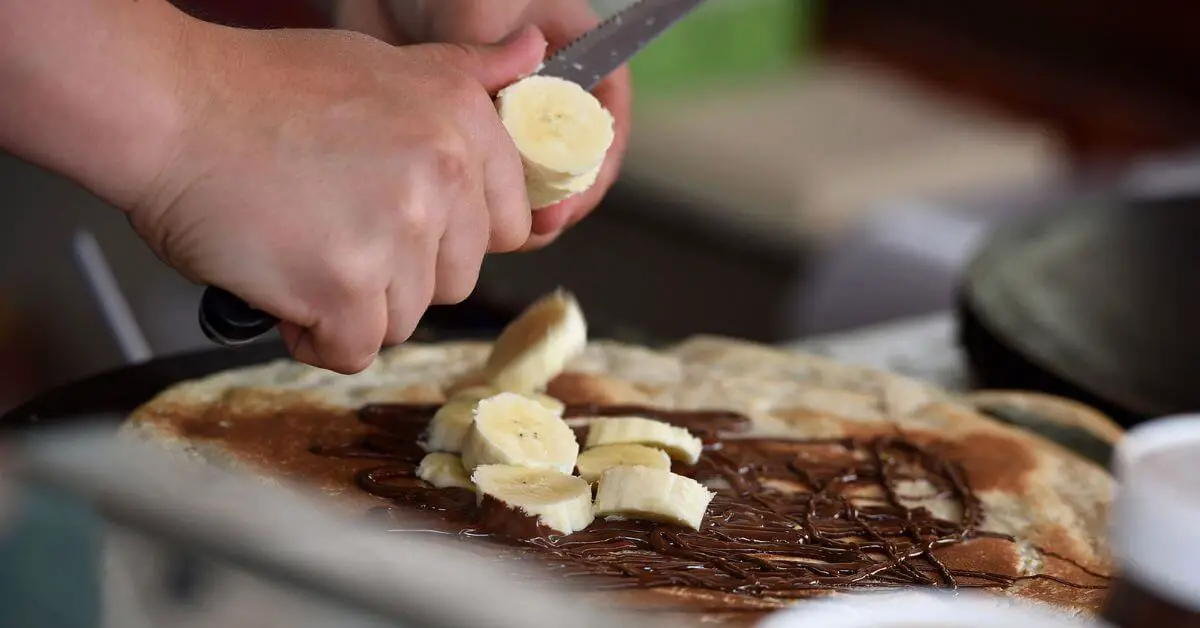Crepes, a staple in French cuisine, have captivated food enthusiasts worldwide with their delicate texture and versatility. Originating from the picturesque region of Brittany, these thin pancakes have evolved from a simple peasant meal to a beloved dish celebrated in high-end Parisian restaurants and homes globally. The journey of crepes through history is not just a culinary tale but a reflection of cultural evolution and innovation.
The Invention of Crepes
The crepes history begins with a serendipitous accident in the kitchen of Monte Carlo’s Café de Paris. In 1895, a young assistant waiter named Henry Carpentier was preparing a dessert for the Prince of Wales, the future King Edward VII. Amidst the hustle, Carpentier accidentally created what would become a world-renowned dish. This incident marked the birth of the now-famous Crepes Suzette, a dish that epitomizes culinary elegance and creativity.
The Prince of Wales was so impressed by this delightful creation that he suggested naming it after one of his guests. However, the name that stuck was “Suzette,” a testament to the dish’s charm and the prince’s influence. This moment in culinary history is not just about the birth of a dish but also highlights the fusion of French cooking techniques and aristocratic elegance. Learn more about Edward VII and his influence on European cuisine.
Crepes in Ancient Times
Tracing back to the 13th century, the history of crepes takes us to Brittany, a region renowned for its rich culinary traditions. Here, a housewife accidentally dribbled some thin porridge onto a hot cooktop, giving rise to the first crude form of crepes. This humble beginning marks the transformation of a simple mistake into a culinary staple.
The term crêpe is derived from the Old French word “crespe,” which comes from the Latin “crispa,” meaning “curled.” The basic ingredients of flour, eggs, milk, and butter, cooked on a hot plate or frying pan, have remained largely unchanged over the centuries. This simplicity is a hallmark of many traditional European cuisines, where the focus is on enhancing the natural flavors of a few key ingredients.
Brittany’s introduction of buckwheat flour in the 1100s further revolutionized crepe-making, adding a new dimension to this already versatile dish. The region’s culinary heritage is deeply intertwined with the history of crepes, making it a significant part of French cooking. Discover more about Brittany’s regional food and its impact on French gastronomy.
The Evolution of Crepe Recipes

The journey of crepes from a regional specialty in Brittany to a beloved dish across Europe is a testament to their versatility and universal appeal. Originally, crepes were made with buckwheat flour, a staple in Brittany, reflecting the agricultural produce of the region. This rustic version, known as Galette Bretonne, was a hearty, nutritious meal, often accompanied by cider.
As crepes gained popularity, they began to be made with white flour, leading to the delicate, lace-like crepes we are familiar with today. This evolution from buckwheat to white flour crepes marked a shift in their culinary role, from a simple, filling meal to a refined, elegant dish.
The spread of crepes across Europe brought about a myriad of variations, influenced by local ingredients and culinary traditions. In Italy, they transformed into crespelle, often used in layered dishes similar to lasagna. In Eastern Europe, crepes took on a sweeter role, filled with jams, fruits, and creams.
This adaptability of crepes is a reflection of the creativity and innovation inherent in European cuisine. They became a canvas for chefs and home cooks to express their culinary artistry, blending traditional French techniques with regional flavors. The evolution of crepe recipes is not just a culinary journey but a story of cultural exchange and adaptation. For more insights into the diverse world of European crepes, explore the history of pancakes and their variations across different cultures.
Crepes Suzette: A Culinary Legend
Crepes Suzette stands as a symbol of the elegance and sophistication of French cuisine. This iconic dish, with its flambeed presentation and rich citrus sauce, has a story that is as captivating as its flavor. The creation of Crepes Suzette at Monte Carlo’s Café de Paris by Henry Carpentier marked a significant moment in the history of French desserts.
The dish’s popularity soared in the early 20th century, especially in Parisian restaurants, where it became a standard in French dessert fare. The theatrical preparation of Crepes Suzette, with the crepes being flambeed in a sauce of sugar, orange juice, butter, and Grand Marnier, added an element of drama and luxury to the dining experience. This method of preparation not only enhanced the flavor but also the overall dining experience, making it a favorite among the elite.
The history of Crepes Suzette is not just about a dish but also about the evolution of dining culture in France. It reflects the shift from rustic, hearty meals to more refined, sophisticated cuisine. The dish’s enduring popularity is a testament to its timeless appeal and the skill of French chefs in creating dishes that are both delicious and visually stunning. For more insights into the art of French cooking, visit the Culinary Arts page on Wikipedia.
Cultural Significance of Crepes in France
Crepes hold a revered place in French culture, symbolizing the essence of French cuisine. Each French region, with its unique preparation and serving methods, celebrates crepes, reflecting the diversity and richness of French culinary traditions.
- In Brittany, locals traditionally make crepes with buckwheat flour and often serve them with a glass of cider, showcasing the region’s proud agricultural heritage.
- In urban areas like Paris, street vendors commonly offer crepes filled with a variety of sweet and savory toppings, making them a popular choice for a quick and delicious meal.
Beyond their taste, crepes symbolize hospitality and celebration in France. Families across the country often prepare crepes on Chandeleur (Candlemas), a holiday that brings people together to enjoy this simple yet delightful dish. This tradition, rich in folklore, involves flipping a crepe in the pan while holding a coin in the other hand, a practice believed to bring prosperity.
Crepes also feature prominently in French literature and art, often depicted as an integral part of everyday life. This portrayal highlights their status as a quintessential element of French culture, cherished across generations. To delve deeper into the cultural aspects of crepes and their influence on French gastronomy, explore the Culture of Paris page on Wikipedia.
Modern Variations of Crepes
Crepes have evolved far beyond their French roots, embracing global flavors. This evolution showcases their incredible adaptability. Chefs worldwide experiment with crepes, blending traditional French techniques with local tastes. This fusion results in unique, innovative dishes.
In the United States, crepes often feature sweet, indulgent fillings. Favorites include chocolate, strawberries, and whipped cream. These fillings cater to the American preference for sweetness. In Asia, particularly Japan, crepes incorporate local flavors. Ingredients like matcha, red bean paste, and mochi are common.
This global adaptation highlights crepes’ versatility. They serve as a canvas for culinary creativity, allowing for endless possibilities. In contemporary cuisine, crepes are not just a dish but a medium for cultural expression. They reflect the blending of culinary traditions from around the world.
Social media has played a significant role in popularizing crepes. Food blogs, cooking channels, and Instagram posts often feature them. This exposure has introduced crepes to a new generation of food enthusiasts. It ensures their place in the global culinary landscape.
Explore another dish that has stood the test of time, similar to crepes. Dive into the culinary journey of Mamaliga, a dish rich in tradition and innovation.
Crepes history in Popular Culture
Crepes have not only made their mark in the culinary world but also in popular culture. They frequently appear in movies, books, and television shows, often used as a symbol of French elegance and sophistication. This portrayal in media has played a significant role in popularizing crepes beyond the borders of France.
- In film, crepes are often associated with romantic scenes or depicted as a luxurious treat in high-end restaurants.
- In literature, they are used to evoke a sense of nostalgia or to represent the simplicity of French country life.
The depiction of crepes in popular culture has contributed to their mystique and allure. It has made them not just a food item but a cultural icon, representing a lifestyle that values fine dining and the pleasures of good food. This portrayal has helped maintain the popularity of crepes and sparked interest in French cuisine among audiences worldwide. For a glimpse into the world of crepes in movies and books, explore European Desserts on Pinterest.
Making Crepes at Home

Creating crepes at home is both an enjoyable and rewarding culinary experience. The basic crepe batter, a blend of flour, eggs, milk, and a pinch of salt, is straightforward to prepare. This foundation allows for endless creativity in both sweet and savory dishes.
- For sweet crepes, enhance the batter with a touch of sugar and vanilla. This addition brings a subtle sweetness, perfect for dessert crepes.
- For savory crepes, consider adding herbs or spices to the batter for an extra flavor dimension.
The secret to perfect crepes lies in the consistency of the batter and the technique of cooking. The batter should be fluid enough to spread thinly and evenly across a well-heated, lightly greased pan. Achieving the ideal thinness is key to creating the delicate, lace-like texture that crepes are known for.
Flipping crepes requires a gentle yet confident touch. It’s an art that improves with practice, adding to the fun of crepe-making.
When it comes to fillings, the possibilities are limitless:
- Sweet options include Nutella, fresh fruits like strawberries or bananas, and whipped cream.
- Savory fillings can range from cheese and ham to spinach, mushrooms, or a combination of vegetables.
Crepes offer a delightful way to explore culinary creativity, making them a perfect dish for both novice cooks and seasoned chefs. For more inspiration on crepe fillings and recipes, explore French Recipes on Pinterest.
FAQs
Where did crepes originate?
Crepes trace their origins to Brittany, France, in the 13th century. Initially, peasants made them with buckwheat flour, serving as a nutritious staple.
What ingredients make up a traditional crepe?
A traditional crepe consists of flour, eggs, milk, and butter. Cooks spread this batter thinly on a hot surface to create a delicate pancake.
Are crepes exclusively a dessert?
Crepes are versatile and can be either savory or sweet. Savory crepes, often made with buckwheat flour, include fillings like cheese, ham, and vegetables. Sweet crepes, typically made with white flour, feature fillings such as fruits, chocolate, or cream.
How do crepes differ from pancakes?
Crepes are thinner and more delicate than pancakes. Their liquid batter spreads thinly across the pan, unlike the thicker, fluffier texture of pancakes.
Can you make crepes ahead of time?
Yes, you can prepare crepes in advance and store them in the refrigerator or freezer. Reheat them in a pan or microwave before serving.
What is Crepes Suzette?
Crepes Suzette is a renowned French dessert comprising crepes with a caramelized sugar, butter, orange juice, zest, and Grand Marnier sauce. Often, chefs flambe the crepes for a dramatic effect.
Are crepes gluten-free?
Traditional crepes contain wheat flour and are not gluten-free. However, you can make gluten-free versions using alternative flours like buckwheat or rice flour.
What are some popular crepe fillings?
Popular sweet crepe fillings include Nutella, strawberries, bananas, and whipped cream. For savory crepes, common fillings are cheese, ham, eggs, spinach, and mushrooms.
Conclusion
Crepes, a symbol of French culinary artistry, continue to delight food lovers worldwide. From Brittany to global kitchens, they remain a timeless classic. Their versatility and simplicity ensure their enduring popularity across cultures.
